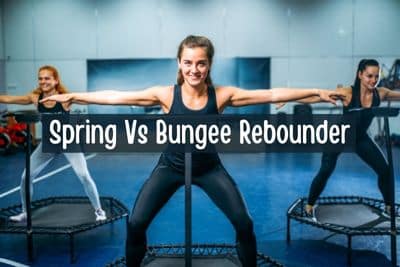Mini-trampolines are classified as spring and non-spring (bungee) rebounders depending upon their springs and bungee cords, respectively. Both types have some pros and cons, and there are several differences between them.
So, what are the dissimilarities between spring vs bungee rebounders? Bungee cord mini-trampolines are silent and gentle bounce trampolines, whereas spring rebounders give quite a harsh bounce. In terms of safety, bungee rebounders get the medal. Considering the price, spring models win over the band rebounders.
Here, I’m explaining with or without springs mini-trampoline so you can choose the right one for home exercise. Let’s get started!
How Does a Spring Mini Trampoline Work?
In the spring rebounder trampoline, springs connect the mat and trampoline frame together. For safety, springs are covered by thick padding. The best rebounders with springs use tapered springs.
Spring mini-trampoline rebounder provides firm bounce; thus, you can do more than just jump there. These fitness trampolines are good for hopping and jogging too.
While buying a spring-based small trampoline, make sure the springs come with good health as some manufacturers sell outdated items that might cause safety hazards as well as health problems.
The firmness of the springs makes the rebounder less elastic. So, if you are looking for a good rebounder for seniors, the springs model will be a great choice.
How Does a Bungee Mini Trampoline Work?
Another type of exercise trampoline uses bungee cords to attach the mat with trampoline rims. These bungees or bands are flexible. Thus, you will get superb elasticity from the springless rebounder, which is very helpful for your ligaments and joints.
Elastic band rebounders help you do harder workouts due to higher bouncing capacity. This will also burn lots of calories to make you healthy.
If you don’t love to hear springs squeak, bungee cord mini trampolines will be your right pick. This type of silent exercise may help you to improve your mental health also.
With or Without Springs Rebounder: Differences
After knowing the working principle of both fitness trampolines, let’s break down the difference between spring vs non-spring rebounders.

a) Material
The name is self-explanatory for each mini-trampoline. Bungee rebounders use bungee cords or elastic bands, whereas spring rebounders have rustproof springs to generate bounces.
b) Durability
Springs are less prone to break sooner than bungee ropes. But springs will form rust over time, whereas elastic bands haven’t any chance of rusting. Most bungees last longer, but some poor-quality bands might snap soon.
c) Bouncing Style
Both springs and bungee cords rebounders are good for providing low-impact exercise. But spring trampolines are quite harsh than bungee rebounders.
Usually, bungee rebounders burn more calories than the spring models. So, if you need a rebounder for lymphatic drainage, an elastic band trampoline will be the most suitable option for you.
d) Setup
Most bungee strap rebounders come in the pre-assembled condition that needn’t any additional setup. On the other hand, springs mini trampolines need to hook all the springs with the mat and frame, which require time and effort.
FYI, springs are installed using a spring tool or its alternatives, whereas bungee cords are assembled in the trampoline using the specially made bungee tool.
See Also: Mini trampoline assembly & disassembly tips
e) Safety
The elastic cords provide a gentle bounce that supports your joints and ligaments. Also, this low-impact equipment won’t hurt you. But springs might cause an adverse effect on joints, especially when you jump on broken or rusty springs.
Moreover, the springless design provides extra safety that eliminates spring impact and pinching hazards. But springs mini trampolines have a greater risk of spring injury; thus, spring padding is essential.
f) Squeak
Bungees provide noiseless exercise due to their construction. But springs might squeak frequently. This is an important reason why fitness enthusiasts are choosing bungee cord mini-trampoline over spring rebounding systems.
g) Price
The price of spring and bungee trampoline differs from each other. Spring rebounders are widely used and an affordable option. On the other hand, bungee trampolines are usually more expensive than most spring mini-trampolines.
Bungee Mini-Trampolines: Pros and Cons
Pros:
- Affordable than elastic band models
- Firm bounce that is ideal for beginner
Cons:
- Unpleasant noise
- Bounce seems harsher for joints than bungee models
- Springs require frequent replacement
See Also: Difference between trampoline and rebounder
Spring Mini-Trampolines: Pros and Cons
Pros:
- Silent bouncing platform
- Joints friendly, gentle bounce
- Almost risk-free
Cons:
- High-end models are too expensive
See Also: Heavy adults rebounders
Bungee vs Spring Rebounder: Comparison Table
For quick learners, the following comparative table will help to understand whether springs or bungee cords for mini trampolines will be suitable for you.
| Comparison Topic | Spring Rebounder | Bungee Rebounder |
| Setup | Need attaching the springs with the frame and mat | Pre-assembled |
| Safety | Springs might be hazardous | Safer than spring models |
| Bouncing Quality | Harsher than bungee models | Gentle bounce |
| Noise | Springs may be squeaky | Noiseless silent exercise |
| Price | Very affordable | Little expensive |
To learn more about bungee cords vs spring rebounders, you can watch the video-
Final Verdict
So, we come to the end of the spring vs bungee rebounder debate. If you need a noise-free gentle bounce, bungee rebounders will suit you best. But spring models are versatile and come at a cheaper price.
In fact, bungee rope rebounders win over springs trampolines in overall consideration. Still, you can choose the spring model, as the ultimate choice is up to you.

Rebecca is a fitness nerd and mother. She was inspired to get into the world of trampolining and rebounding by her husband Robert, who is a well-respected trainer and expert in the field. Now she instructs children, mothers, and teens the basic trampolining and rebounding tricks.
Rebecca is also a passionate blogger, sharing her knowledge and experiences with others in the hope of encouraging them to give trampolining and rebounding a try.
